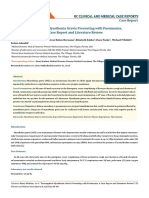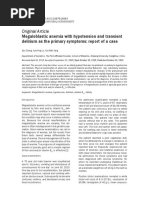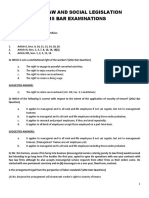AIHA
AIHA
Uploaded by
Kristine Mae AbrasaldoCopyright:
Available Formats
AIHA
AIHA
Uploaded by
Kristine Mae AbrasaldoOriginal Description:
Copyright
Available Formats
Share this document
Did you find this document useful?
Is this content inappropriate?
Copyright:
Available Formats
AIHA
AIHA
Uploaded by
Kristine Mae AbrasaldoCopyright:
Available Formats
Pulmonary Tuberculosis Associated
with Autoimmune Hemolytic Anemia:
An Unusual Presentation
Mehmet TURGUT*, Ouz UZUN**, Engin KELKTL*, Okay ZER*
* Department of Hematology, Medical School, Ondokuz Mays University,
** Department of Chest Medicine, Medical School, Ondokuz Mays University, Samsun, TURKEY
ABSTRACT
Coombs positive hemolytic anemia is exceedingly rare in tuberculosis. We herein report a patient with tuberculosis associated with Coombs positive hemolytic anemia that was responded to antituberculosis therapy. She was
admitted to the hospital because of recent-onset fatigue, weakness, nonproductive cough, pallor and scleral jaundice. Coombs positive hemolytic anemia and pulmoner tuberculosis was diagnosed. Following antituberculosis therapy, laboratory and clinical finding related to autoimmune hemolytic anemia disappeared.
Key Words: Tuberculosis, Autoimmune hemolytic anemia, Coombs positivity.
Turk J Haematol 2002;19(4): 477-480
Received: 29.04.2002
Acceppted: 13.08.2002
INTRODUCTION
Tuberculosis is a multi-systemic specific infection,
which can lead protean manifestations in any organsystem. Therefore, the clinical presentation of the disease is quite diverse. Hematological finding in tuberculosis is not uncommon and usually due to non-immunological mechanisms. Normochrom normocythic anemia is the most frequent hematological finding at presentation and during the long clinical course of tuberculosis. Anemia is usually due to bone marrow granuloma, nutritional insufficiency, malabsorption and im-
paired iron utilization. Coombs positive hemolytic
anemia is exceedingly rare in tuberculosis. We herein
report a patient with tuberculosis associated with Coombs positive hemolytic anemia that was responded
to antituberculosis therapy.
A CASE REPORT
A 30-year-old previously healthy woman was admitted to the hospital because of recent-onset fatigue,
weakness, nonproductive cough, pallor and scleral jaundice. Physical examination revealed a blood pressure of 80/55 mmHg, pulse 92/min, respiration 35/min
477
Turgut M, Uzun O, Kelkitli E, zer O.
and body temperature 39.5C orally. In the examination of the respiratory system, there were fine rales heard in the left apical zone during inspiration and expiration together with a harsh bronchial noise. There was
a systolic cardiac murmur of grade I-II heard all over
the precordium. The laboratory findings on admission
revealed a WBC 6600/mm3 (75% neutrophils, 13%
lymphocytes, 11% monocytes and 0.5% eosinophiles),
hemoglobin 4.6 g/dL, MCV 98.7 and MCH of 22.7 fL,
platelet count 175.000/mm3 and reticulocyte 19.7%.
Direct and indirect Coombs test was positive without
any transfusion. Erythrocyte morphology was polychromacytic together with macrocytosis, spherocytosis,
anisopoikilocytosis and 6% normoblasts. Bone marrow
examination disclosed significant erythroid hyperplasia and hypercellularity. Biochemical tests on admission were: Total bilirubin 4 g/dL, direct bilirubin 1.9
g/dL, AST 295 IU/L, ALT 81 IU/L, LDH 1902 U/L,
ferritin 7685 ng/dL and haptoglobin 31 mg/dL. In the
chest X-ray there was bilateral reticulonodular infiltration in the upper zones and in the high resolution computerized tomography bilateral apical reticulonodular
infiltration and a cavitary lesion 2 cm in diameter seen
in the right upper lobe posterior segment (Figures 1,2).
Tests for ANA, anti-DNA, HIV and blood cultures were all negative. In the bronchoalveolar lavage obtained
from the right upper pole there were acid-fast bacilli
and Mycobacterium tuberculosis was cultivated in the
Lwenstein-Jensen agar.
The drug regimen including INH 300 mg PO, rifampicine 450 mg PO, pyrazinamide 1500 mg PO and
streptomycine 750 mg IM was initiated in April 2001.
After one week time fever was subsided. Since the liver enzymes were elevated (ALT 540 IU/L and AST
560 IU/L), all of the drugs except streptomycin were
holded and ethambutol 1500 mg PO was added to the
treatment schema. When the enzymes (ALT and
AST) were 39 IU/L and 100 IU/L respectively INH,
pyrazinamide and rifampicine were added to the drug
regimen with 5 days of intervals. There were no increments in the enzymes following the reinitiation of the
treatment. The control laboratory tests of the patient
are depicted in Table 1.
No blood or blood product was given to the patient
and the clinical symptoms were gradually improved.
Patient is discharged because of her will to continue the
treatment at home in June 2001. The sputum examina-
478
Pulmonary Tuberculosis Associated with Autoimmune Hemolytic
Anemia: An Unusual Presentation
Figure 1. Anteroposterior X-ray of the chest on admission showing bilateral reticulonodular infiltration in
upper zones.
Figure 2. HRCT of the patient on admission showing
bilateral apical reticulonodular infiltrations and cavitary lesions.
tion made at July 2001 revealed no acid-fast bacilli and
there were no M. tuberculosis in the control cultures.
The control Chest X-ray obtained in December 2001
showed no abnormalities except the bilateral apical fibrotic opacities.
DISCUSSION
A wide variety of hematological manifestations
can be observed in patients with tuberculosis, which
Turk J Haematol 2002;19(4):477-480
Pulmonary Tuberculosis Associated with Autoimmune Hemolytic
Anemia: An Unusual Presentation
Turgut M, Uzun O, Kelkitli E, zer O.
Table 1. Essential laboratory findings and follow-up of the patient with tuberculosis and hemolytic anemia
Parameters
On admission
Eight months later
4.6
12.2
Reticulocyte (%)
19.7
0.98
LDH (IU/L)
1902
270
4.6/1.9
0.32/0.05
88
20
37
18
31 (N above 50)
80
Hemoglobin (g/dL)
Bilirubin-total/direct (mg/dL)
AST (IU/L)
ALT (IU/L)
Haptoglobin (mg/dL)
has a chronic inflammatory nature. The commonest of
those are anemia and leukocytosis, which are reported
as 60% and 40% respectively[1]. Anemia is present in
63% of miliary tuberculosis patients[2]. Anemia of tuberculosis is usually due to nutritional deficiency, failure of iron utilization, malabsorption syndrome and
bone marrow suppression. However, autoimmune hemolytic anemia is exceedingly rare condition in tuberculosis.
Infection-associated hemolytic anemia is mostly
related to virus and mycoplasmal infections. Four hemolytic anemia cases due to tuberculosis were previously reported in the English literature[3-6]. Only two
of those cases responded to antituberculous chemotherapy alone successfully[3,4]. In the third patient, prednisolone 60 mg three weeks and splenectomy due to subcapsular hemotoma preceded antituberculosis therapy[5]. The fourth patient required prolonged steroid
therapy to prevent the recurrence of hemolysis[6].
Another complicated issue while treating the patients is hemolytic effects of antituberculosis drugs, rifampisin, streptomycin and para-aminosalicylic acid
induced hemolytic anemia reported in the literature[79]. Our patient received both rifampisin and streptomycin, but we did not observe any hemolytic adverse effect of these drugs.
evidences of immune mediated hemolytic anemia due
to tuberculosis.
In summary, pulmonary tuberculosis can cause autoimmune hemolytic anemia, although the exact mechanism of the association is not clear. Fiberoptic bronhoscopic procedure should be instituted in any suspected tuberculosis patient who do not produce sputum.
Because any delay in the diagnosis of tuberculosis in
anemic patients could be life-threatening.
REFERENCES
1.
2.
3.
4.
5.
6.
MacGregor RR. A years experience with tuberculosis in
a private urban teaching hospital in the postsanatorium
era. Am J Med 1975;58:221-8.
Glasser RM, Walker RI, Hewrion JC. The significance
of hematologic abnormalities in patients with tuberculosis. Arch Intern Med 1970;125:691-5.
Siribaddane SH, Wijesundera A. Autoimmune haemolytic anemia responding to antituberculous treatment. Trop
Doc 1997;27:243-4.
Kuo PH, Yang PC, Kuo SS, et al. Severe immune hemolytic anemia in disseminated tuberculosis with response to antituberculosis therapy. Chest 2001;119:19613.
Blance P, Rigolet A, Massault PP, et al. Autoimmune hemolytic anemia revealing miliary tuberculosis. J Infect
2000;40:292.
Cameron SJ. Tuberculosis and the blood: A special relationship? Tubercle 1974;55:55-72.
Disappearance of hematological abnormalities via
antituberculosis therapy alone is an important proof
that tuberculosis is the underlying cause of hemolytic
anemia in our patient. Recovery of hemoglobin, reticulocyte, haptoglobulin, biluribin, levels and Coombs
negativity after antituberculous therapy were all strong
Turk J Haematol 2002;19(4):477-480
479
Turgut M, Uzun O, Kelkitli E, zer O.
7.
8.
9.
Pulmonary Tuberculosis Associated with Autoimmune Hemolytic
Anemia: An Unusual Presentation
Ouz A, Kanra T, Gkalp A, et al. Acute hemolytic anemia caused by irregular rifampicin therapy. Turk J Pediatr 1989;31:83-8.
Letona JM, Barbolla L, Frieyro E, et al. Immune hemolytic anemia and renal failure induced by streptomycin. Br J Haematol 1977;35:561-71.
Mueller-Eckhardt C, Kretschmer V, Coburg KH. Allergic, immunohemolytic anemia due to para-aminosalicylic acid (PAS). Immunohematologic studies of three cases. Dtsch Med Wochenschr 1972;97:234-8.
Address for Correspondence:
Mehmet TURGUT, MD
Denizevler Mahallesi
Erzurum Apartman No: 349/8
TR-55200, Atakum, Samsun, TURKEY
e-mail: mturgut@omu.edu.tr
480
Turk J Haematol 2002;19(4):477-480
You might also like
- Xolair Dosing GuideDocument12 pagesXolair Dosing Guidemohamed muhsinNo ratings yet
- Vaccination Records - AdultsDocument2 pagesVaccination Records - AdultsverumluxNo ratings yet
- 54 Shivraj EtalDocument3 pages54 Shivraj EtaleditorijmrhsNo ratings yet
- A Case of Mushroom Poisoning With Russula Subnigricans: Development of Rhabdomyolysis, Acute Kidney Injury, Cardiogenic Shock, and DeathDocument4 pagesA Case of Mushroom Poisoning With Russula Subnigricans: Development of Rhabdomyolysis, Acute Kidney Injury, Cardiogenic Shock, and DeathsuserNo ratings yet
- Respiratory and Pulmonary Medicine: ClinmedDocument3 pagesRespiratory and Pulmonary Medicine: ClinmedGrace Yuni Soesanti MhNo ratings yet
- A Case of Typhoid Fever Presenting With Multiple ComplicationsDocument4 pagesA Case of Typhoid Fever Presenting With Multiple ComplicationsCleo CaminadeNo ratings yet
- New Paraneoplastic Syndrome in Chronic Basophilic LeukemiaDocument7 pagesNew Paraneoplastic Syndrome in Chronic Basophilic Leukemiagalih hayyusalimPNo ratings yet
- Crim Em2013-948071Document2 pagesCrim Em2013-948071m.fahimsharifiNo ratings yet
- Anak 1Document4 pagesAnak 1Vega HapsariNo ratings yet
- Delay in Diagnosis of Extra-Pulmonary Tuberculosis by Its Rare Manifestations: A Case ReportDocument5 pagesDelay in Diagnosis of Extra-Pulmonary Tuberculosis by Its Rare Manifestations: A Case ReportSneeze LouderNo ratings yet
- TMP 155 BDocument7 pagesTMP 155 BFrontiersNo ratings yet
- Pulmonary Miliary Tuberculosis Complicated With Tuberculous Spondylitis An Extraordinary Rare Association: A Case ReportDocument5 pagesPulmonary Miliary Tuberculosis Complicated With Tuberculous Spondylitis An Extraordinary Rare Association: A Case ReportIsmail Eko SaputraNo ratings yet
- Pulmonary Balantidium Coli Infection in A Leukemic PatientDocument4 pagesPulmonary Balantidium Coli Infection in A Leukemic PatientNika Dwi AmbarwatiNo ratings yet
- A Case Report On Sickle Cell Disease With Hemolyti PDFDocument4 pagesA Case Report On Sickle Cell Disease With Hemolyti PDFAlhaji SwarrayNo ratings yet
- PHOJ D 24 00049 - ReviewerDocument11 pagesPHOJ D 24 00049 - ReviewerAdityaNo ratings yet
- Megaloblastic Anemia in A Patient With Addison's Disease: A Case ReportDocument4 pagesMegaloblastic Anemia in A Patient With Addison's Disease: A Case ReportIzzan Ferdi AndrianNo ratings yet
- ajol-file-journals_476_articles_246174_submission_proof_246174-5617-590351-1-10-20230420Document11 pagesajol-file-journals_476_articles_246174_submission_proof_246174-5617-590351-1-10-20230420lana qwqwMagdyNo ratings yet
- 10clinical VignettespdfDocument71 pages10clinical VignettespdfKerin Ardy100% (1)
- Manuscript Case Report Addison's Disease Due To Tuberculosis FinalDocument22 pagesManuscript Case Report Addison's Disease Due To Tuberculosis FinalElisabeth PermatasariNo ratings yet
- Septic ShockDocument2 pagesSeptic ShockLatifah LàNo ratings yet
- PIIS1198743X14652605Document3 pagesPIIS1198743X14652605Gerald NacoNo ratings yet
- Case ReportDocument5 pagesCase ReportRifqiNo ratings yet
- Zhao 2021Document9 pagesZhao 2021Marlon NeryNo ratings yet
- Cureus 0015 00000038234Document8 pagesCureus 0015 00000038234Anggita Nara SafitriNo ratings yet
- Seronegative Myasthenia Gravis Presenting With PneumoniaDocument4 pagesSeronegative Myasthenia Gravis Presenting With PneumoniaJ. Ruben HermannNo ratings yet
- Argy Raki 2011Document3 pagesArgy Raki 2011Aline Paula FontesNo ratings yet
- A Case of Lupus Pneumonitis Mimicking As Infective PneumoniaDocument4 pagesA Case of Lupus Pneumonitis Mimicking As Infective PneumoniaIOSR Journal of PharmacyNo ratings yet
- Rhizomucor Scedosporium: Case ReportDocument6 pagesRhizomucor Scedosporium: Case ReportPaul ColburnNo ratings yet
- Secondary Hemophagocytic Lymphohistiocytosis: A Rare Case ReportDocument5 pagesSecondary Hemophagocytic Lymphohistiocytosis: A Rare Case ReportivanNo ratings yet
- Evans Syndrome - A Study of Six Cases With Review of LiteratureDocument6 pagesEvans Syndrome - A Study of Six Cases With Review of Literaturedrrome01No ratings yet
- 2014 Kabir Et Al. - Chronic Eosinophilic Leukaemia Presenting With A CDocument4 pages2014 Kabir Et Al. - Chronic Eosinophilic Leukaemia Presenting With A CPratyay HasanNo ratings yet
- Pernicious Anemia in Young: A Case Report With Review of LiteratureDocument5 pagesPernicious Anemia in Young: A Case Report With Review of LiteratureeditorijmrhsNo ratings yet
- Pancytopenia Secondary To Bacterial SepsisDocument16 pagesPancytopenia Secondary To Bacterial Sepsisiamralph89No ratings yet
- 과립구집락자극인자 투여로 치료한 범혈구감소증과 피부 박리를 보인 붉은사슴뿔버섯 중독 1례Document5 pages과립구집락자극인자 투여로 치료한 범혈구감소증과 피부 박리를 보인 붉은사슴뿔버섯 중독 1례김성현No ratings yet
- 56 SyedDocument3 pages56 SyededitorijmrhsNo ratings yet
- Interferon Gamma Production in The Course of Mycobacterium Tuberculosis InfectionDocument9 pagesInterferon Gamma Production in The Course of Mycobacterium Tuberculosis InfectionAndia ReshiNo ratings yet
- Case Study Report 1 Sickle Cell AnemiaDocument12 pagesCase Study Report 1 Sickle Cell Anemiaapi-386292726100% (1)
- 4627-Article Text Orig-42997-1-10-20240527Document4 pages4627-Article Text Orig-42997-1-10-20240527mcmxcigameNo ratings yet
- Assessment of Splenic Function: ReviewDocument9 pagesAssessment of Splenic Function: Reviewjosias_aragao3527No ratings yet
- Hairy Cell Leukemia: Functional, Immunologic, Kinetic, and Ultrastructural CharacterizationDocument13 pagesHairy Cell Leukemia: Functional, Immunologic, Kinetic, and Ultrastructural CharacterizationAna Rubí LópezNo ratings yet
- Acute Lymphoblastic Leukemia With Hypereosinphilia in A Child 2018Document8 pagesAcute Lymphoblastic Leukemia With Hypereosinphilia in A Child 2018David MerchánNo ratings yet
- High FerritinDocument3 pagesHigh FerritinBogdan ToaderNo ratings yet
- PIIS235251262300019XDocument4 pagesPIIS235251262300019Xluiz_3005No ratings yet
- Practice: Kikuchi-Fujimoto Disease: Lymphadenopathy in SiblingsDocument4 pagesPractice: Kikuchi-Fujimoto Disease: Lymphadenopathy in SiblingsBobby Faisyal RakhmanNo ratings yet
- Edit Case AnalysisDocument25 pagesEdit Case AnalysisAmel YangNo ratings yet
- Acute Fulminent Leptospirosis With Multi-Organ Failure: Weil's DiseaseDocument4 pagesAcute Fulminent Leptospirosis With Multi-Organ Failure: Weil's DiseaseMuhFarizaAudiNo ratings yet
- Thromboembolic Complications After Splenectomy For Hematologic DiseasesDocument5 pagesThromboembolic Complications After Splenectomy For Hematologic DiseasesDipen GandhiNo ratings yet
- Staphy 2Document5 pagesStaphy 2Alexandra MariaNo ratings yet
- Fulminant Leptospirosis (Weil's disease)Document22 pagesFulminant Leptospirosis (Weil's disease)drhanymoonyNo ratings yet
- Pediatric Systemic Lupus Erythematosus Associated With AutoimmuneDocument9 pagesPediatric Systemic Lupus Erythematosus Associated With AutoimmunegistaluvikaNo ratings yet
- LepsDocument4 pagesLepslynharee100% (1)
- 41anurag EtalDocument2 pages41anurag EtaleditorijmrhsNo ratings yet
- Oxford University PressDocument9 pagesOxford University PresssarafraunaqNo ratings yet
- Linezolide Pure Red Cell AplasiaDocument3 pagesLinezolide Pure Red Cell Aplasiaendah rahmadaniNo ratings yet
- Original Article: Megaloblastic Anemia With Hypotension and Transient Delirium As The Primary Symptoms: Report of A CaseDocument5 pagesOriginal Article: Megaloblastic Anemia With Hypotension and Transient Delirium As The Primary Symptoms: Report of A CaseNindy PutriNo ratings yet
- Autoimmune Hemolytic Anemia Warm-Antibody Type (Warm AIHA) in An 8-Year-Old Balinese GirlDocument5 pagesAutoimmune Hemolytic Anemia Warm-Antibody Type (Warm AIHA) in An 8-Year-Old Balinese GirlFatimatuzzahra ShahabNo ratings yet
- 4Document5 pages4C.G 19No ratings yet
- Case PresentationDocument9 pagesCase Presentationmel aquinoNo ratings yet
- Leptospirosis CasosDocument2 pagesLeptospirosis CasosfelipeNo ratings yet
- Scientific Letters: WWW - Elsevier.es/eimcDocument2 pagesScientific Letters: WWW - Elsevier.es/eimcfeby1992No ratings yet
- A Comprehensive Exploration of Autoimmune Hemolytic Anemia and Holistic Well-beingFrom EverandA Comprehensive Exploration of Autoimmune Hemolytic Anemia and Holistic Well-beingNo ratings yet
- 2019 Commercial Law Ateneo Summer Reviewer PDFDocument256 pages2019 Commercial Law Ateneo Summer Reviewer PDFGrace D67% (3)
- Minor EmergenciesDocument814 pagesMinor EmergenciesKristine Mae Abrasaldo100% (2)
- Closed Head Injury in Adults-Summary-2011Document35 pagesClosed Head Injury in Adults-Summary-2011Kristine Mae AbrasaldoNo ratings yet
- Labor Addendum Bar QA (2012-2015)Document73 pagesLabor Addendum Bar QA (2012-2015)Kristine Mae AbrasaldoNo ratings yet
- How To HandWash Poster 100102 PDFDocument1 pageHow To HandWash Poster 100102 PDFKristine Mae AbrasaldoNo ratings yet
- Necrotizing Fasciitis (Autosaved)Document23 pagesNecrotizing Fasciitis (Autosaved)19-1 NUR ALIMNo ratings yet
- Uretritis GonoreDocument16 pagesUretritis GonoreUswatun HasanahNo ratings yet
- FscommoncoldDocument2 pagesFscommoncoldhakmoch hakmNo ratings yet
- Pneumonia Teaching PlanDocument5 pagesPneumonia Teaching PlanRaghav RoyNo ratings yet
- Green Book Chapter 18 v2 0Document25 pagesGreen Book Chapter 18 v2 0amoon08.arNo ratings yet
- PBMC PosterDocument1 pagePBMC Poster米許No ratings yet
- Anatomy and Physiology/Lymphatic System Chapter 10-ObjectivesDocument9 pagesAnatomy and Physiology/Lymphatic System Chapter 10-ObjectivesJustine May Balinggan DelmasNo ratings yet
- Bronchopneumonia Lesson PlanDocument16 pagesBronchopneumonia Lesson Planlijalem taye100% (1)
- TonsilitisDocument23 pagesTonsilitisatai-phin-4632100% (4)
- Chapter 4.3 Child Care and Services 2022Document67 pagesChapter 4.3 Child Care and Services 2022Nicole Sales DiazNo ratings yet
- Vaccine Certificate AbhimanyuDocument1 pageVaccine Certificate AbhimanyuAbhimanyu MahadikNo ratings yet
- Bubonic Plague - ) ) )Document16 pagesBubonic Plague - ) ) )joygoodworldNo ratings yet
- Mantoux TestDocument22 pagesMantoux TestHazimah HamilinNo ratings yet
- Sesi 3. Dr. YaniDocument35 pagesSesi 3. Dr. YaniannewidiatmoNo ratings yet
- Leveraging Virucidal Potential of An Anti-Microbial Coating Agent To Mitigate Fomite Transmission of Respiratory VirusesDocument13 pagesLeveraging Virucidal Potential of An Anti-Microbial Coating Agent To Mitigate Fomite Transmission of Respiratory VirusesJovanaNo ratings yet
- Acute Bacterial and Viral MeningitisDocument16 pagesAcute Bacterial and Viral MeningitisMaharani MahaNo ratings yet
- Communicable Disease Nursing Post TestDocument3 pagesCommunicable Disease Nursing Post TestTomzki Cornelio100% (1)
- Antigen ReceptorsDocument25 pagesAntigen ReceptorsIsmadth2918388No ratings yet
- Biography of Karl LandsteinerDocument3 pagesBiography of Karl LandsteinerZairin ZulaikhaNo ratings yet
- A Case Report On Symptomatic Primary Herpetic Gingivostomatitis (New)Document4 pagesA Case Report On Symptomatic Primary Herpetic Gingivostomatitis (New)Annisa MardhatillahNo ratings yet
- Lista HalosDocument1 pageLista Halosjhonjames1292gmail.comNo ratings yet
- Patofisiologi Spondilitis Ankilosis PDFDocument5 pagesPatofisiologi Spondilitis Ankilosis PDFTya VenyNo ratings yet
- Biomedical Science 2nd Year Immunology Course IntroductionDocument28 pagesBiomedical Science 2nd Year Immunology Course IntroductionWazzaapXDNo ratings yet
- Z223Document7 pagesZ223mk1655978191No ratings yet
- Next Generation AntibodiesDocument30 pagesNext Generation AntibodiesMeitei IngobaNo ratings yet
- 10.daftar PustakaDocument4 pages10.daftar PustakaLembaga Pendidikan dan PelayananNo ratings yet
- CMPA Beyond InfancyDocument32 pagesCMPA Beyond InfancytioNo ratings yet
- Defence Mechanism of Oral CavityDocument15 pagesDefence Mechanism of Oral CavityANUBHANo ratings yet






























































































